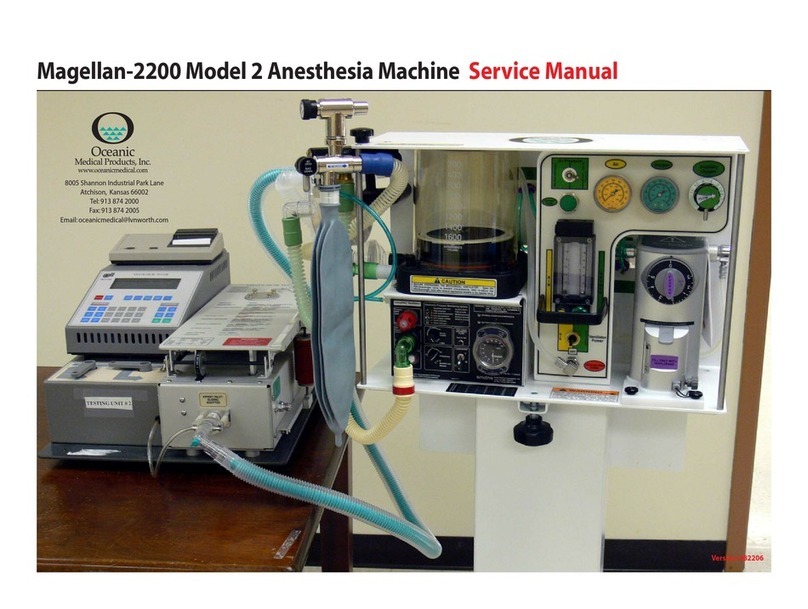
4
CO2 Absorber Holding Bracket Plastic,securedwithknob tomain frameof machine
Bag-Ventilator Switch/PRV Hand-operated selector switch and rotating knob for PRV
and Scavenger Outlet Port andscavengingoutlet
Bellows Latex free,upward inflating,range from 0 to 1.6 L
Bellows Pressure Relief Pre-set at 60 cmH2O
Common Gas Outlet Quick-connect,size indexed
Tubing Circuit King Systems F-360-61 or any standard anesthesia
circle circuit
Gas Pressure Hoses DISSand threadindexed,female connectors atboth ends
Gas Inlet Manifold DISSandthreadindexed,maleconnectorswithone-wayvalves
Gas Inlet Manifold Filters Located behindManifold Air and O2inlet male connectors
Gas Inlet Pressure Regulators
• Main supply cylinder DISS/thread indexed for O2
• Safety back up cylinder Pin-indexed,yoke mounted for "D" and "E" cylinders for O2
Oxygen and Air Supply Gauges 0-3000 psi range,color coded and clearly labeled
Oxygen Supply Alarms
• Main and safety back-up Pneumatically actuated when O2supply falls below 30 psi
• O2 Concentrator Pneumatically actuated when O2supply falls below 1 psi
• Alarm power source 9-volt battery located in body of alarm box
• Alarm on/off Labeledtoggle switch locatedon body of alarm box
Air and O2 Flowmeters Calibrated and scaled 0-10lpm,color coded,O2flowmeter
hasa fluted controlknob for easy identificationby touch,
alone
Oxygen Concentrator TopowerO2flowmeter only
Air Compressor May be used to power ventilator and air flowmeter
Oxygen Analyzer/Monitor OM-25-ME (orequivalent) Galvanic cell sensor,life
expectancy 2 years under normal conditions
Oxygen Analyzer Power Source 2 each AA batteries,life expectancy approx.3000 use hours
Auxiliary O2 Flow Selector Scaled 0-10LPM in set increments,usedforpre/post
anesthesia
Vaporizer PenlonSigmaDeltaSeries,bolt(cage)mounted,
temperature compensated,very low maintenance
Airway Pressure Gauge Dual scaled in cmH2Oand mmHg,located on front
panel of ventilator
Pressure Gauge Tubing May be attached to bag/vent switch arm or to a point
withinthepatientbreathingcircuit(operatorschoice).
MechanicalVentilator Pneumatically powered,time cycled, volume constant,
flow variable
•Ventilator Pressure Relief Pre-set to maximum of60 cmH2Olocated in mainventbox
• MinuteVolume Range 6 to 14 L
• Insp.Flow Range 10 to 40 L/min
• Frequency breaths per minute 10 to 30
• Exp.Ratio-Fixed 1:1.8nominal
Ventilator Gas Power 40to 70 psi,50 psi optimal
Requirements Usetoggleswitch toselect gas source
Waste Gas Scavenger Positiveandnegativereliefvalves,1Lreservoir bag,
vacuum control knob
Total Machine Gas Leakage @ 30 cmH2O -0- ml/Min
@ 80 cmH2O -0- ml/min
Internal System Compliance @ 20 cmH2O 1.1 ml/cmH2O
@ 40 cmH2O 1.3 ml/cmH2O
Internal System Resistance @ 1.0 L/sec gas flow 4.11 cmH2O
@ 0.5 L/sec gas flow 1.80 cmH2O
APL Valve Pressure Drop @ 3.0 L/min gas flow 0.12 cmH2O
@ 30 L/min gas flow 1.03 cmH2O
Storage
• Indoor + 160°F Allow unit to warm to normal
• Outdoor - 30°F OR temp for 1hour




























